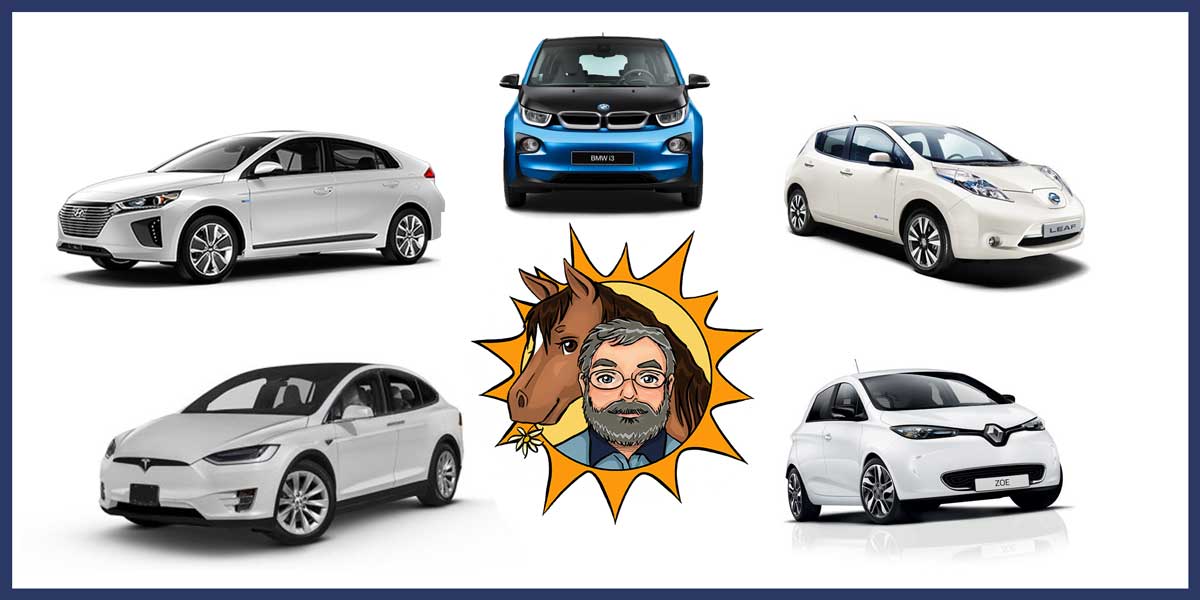
Ronald attended the Charge Together electric vehicle event In Adelaide. Here’s what happened…
I attended an electric car event here in Adelaide on Sunday. I thought it was a reasonable thing to do as I’d recently written about how electric cars don’t result in more CO2 emissions than the typical petrol car. Because some people have made apples to oranges comparisons between the greenhouse gas emissions produced by, lower performance petrol cars and larger, higher performance electric cars when charged from the grid, it seemed like a good idea to see with my own eyes that these people aren’t being fair dinkum.
I also wanted to get a hands on feel for the size and performance of the electric cars that were on display because it doesn’t matter how much you study performance statistics or videos on the internet, nothing is quite like watching an electric car take off in real life and seeing it through your very own smartphone screen.
Charge Together
The event was organized by Charge Together, which is an organization of electric car enthusiasts promoting electric transport and not, as you would expect from the name, a group of kilted Scottish men in a Mel Gibson film. Everyone I met there was very friendly, including electric car owners and the people who were there to check out their vehicles. I don’t want to go pigeonholing people, but I find those with an interest in helping humanity through adopting environmentally benign technology tend to be friendly in a way that people at white power rallies simply aren’t.
Charge Together With Solar
Charge Together promotes the use of solar electricity so electric powered kilometers can be driven emission free. I asked every electric car owner I met if they had rooftop solar panels and every single one did. But not one of them had a solar power system large enough to offset the electricity consumption of a typical household plus an electric car.
No Test Drives For Ronald
I wanted to test drive at least one electric car, but they had to be booked ahead and I left it too late. But this didn’t stop me from volunteering to be a passenger whenever there was a free seat in a vehicle I hadn’t tried. I dived in at every opportunity. I was unstoppable. I passengered like an extinct pigeon. After the first couple of test rides I realized it was actually better than driving. I was able to concentrate on the experience and take notes, not put all my attention into avoiding a smash (or revealing that I can’t actually tell the difference between left and right).
All Electric Cars Have Excellent Performance
Because of the way their motors work, every electric car that can do highway speeds has excellent acceleration. And every electric car in Australia will be able to do highways speeds. There is no need for gears so the acceleration is uninterrupted. This means every electric car in Australia will have better performance in town than all but the most expensive conventional cars.
While the official 0 to 100 time for the current Nissan Leaf of 8 seconds may not seem that great compared to petrol cars with plenty of grunt, it’s the initial rapid acceleration from 1 to 40 that really matters in town and which most petrol cars cannot beat. This is the case even though the Nissan Leaf is designed for middle aged Japanese people, not boy racers.
High Performance Is Not Needed But Is Definitely Wanted
Back in 1980 the average performance of cars was far worse than it is now but I don’t think people were any less happy with them. In fact, I’d even say they enjoyed them more, even though they broke down more. But for better or worse — probably worse — people have shown they are willing to pay for performance and electric cars can give them bucket loads of it. This is one of the reasons why I think, in a few years, electric cars will roll over the competition.
Five Electric Cars
I rode in four electric vehicles and got plenty of good information on another. As expected, they were all very nippy and I think it’s quite possible one of them broke the nip barrier. Despite being different from a conventional car, none of the new drivers appeared to have trouble behind the wheel and all seemed happy with the experience.
The cars were the:
- Tesla Model X
- Renault Zoe
- BMW i3
- Hyundai IONIQ
- Nissan Leaf
Tesla Model X
The Tesla X is a crossover SUV. It just looked like a big car to me, but this was the 5 seat version and there is another with 7 seats that is more SUV-ish. It goes back to the future with DeLorean style gull-wing doors. A feature so cool even the 80s weren’t strong enough stop them escaping into the 21st century.
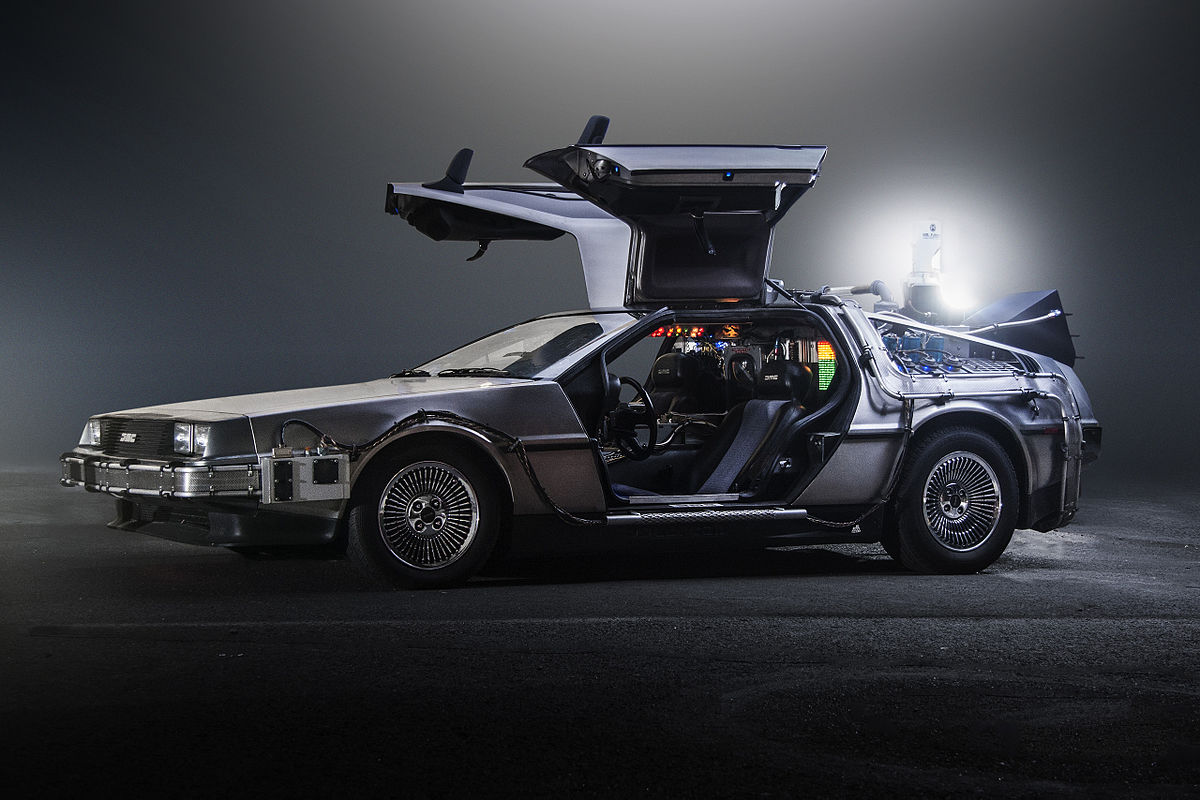
If I could turn back time, If I could find a way, I wouldn’t invest in the DeLorean company, It just won’t pay…
When my Model X ride started it wasn’t as smooth as I expected for a car that costs over $140,000 dollars. Though I must admit I don’t have much experience sitting in expensive luxury cars. People usually ask me to leave when I do that. But without the distraction from a continuous series of fuel-air explosions under the bonnet, it’s easier to pay attention to small bumps in the road. Also, the high efficiency tires weren’t under inflated like when you take a test drive at a car yard.
But then we got onto a straight and the driver decided to floor it. I was able to notice little else except the non-blinding acceleration that pushed me back in the seat like I was riding the Gravitron at the Toowoomba Royal Show. I say non-blinding as it caused blood to pool in the vision centers of my brain. If I had been sitting the other way around it may well have been blinding acceleration. (Although with blood pooling in my frontal lobes and increasing my ability to engage in abstract thought I may have been able to deduce what was going on around me.)
If you value being pushed into upholstery by Newton’s invisible, giant foot1 at $101,000 dollars, then spending $100,000 dollars more to get an electric car with the Model X’s acceleration will be a great deal for you. You could gain enough pleasure to pay it off with one stomp on the accelerator. But it might be cheaper to buy your own Gravitron. (Me and my horse can knock one together for you in your backyard for only $99,000.)
Renault Zoe
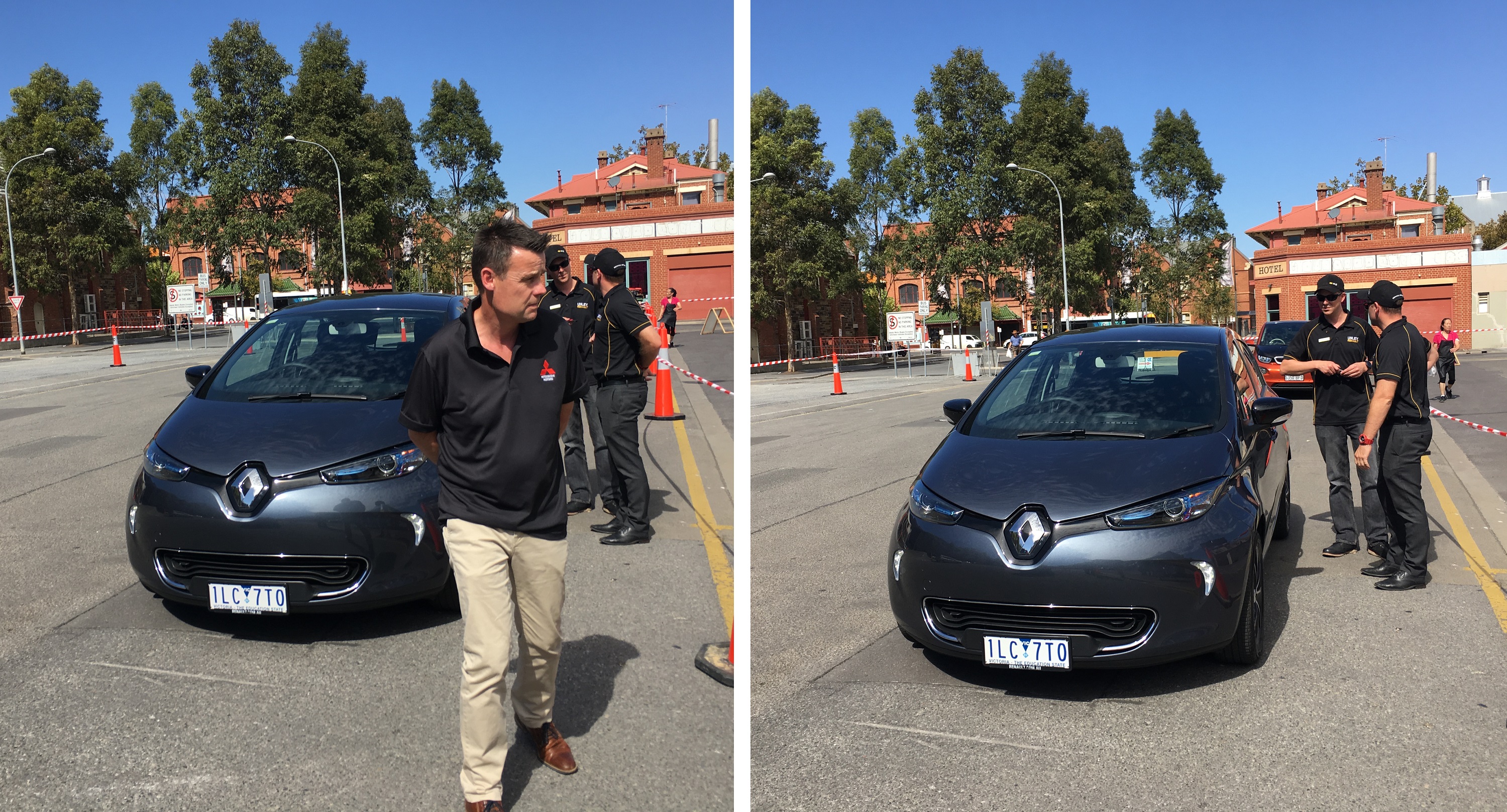
A Renault Zoe being photobombed by Mitsubishi and on its own. (Oh Mitsubishi! You’re such a trickster!)
The Renault Zoe is a supermini. While it is tempting to think this means it’s a super-small mini only suitable for use by jockeys, it actually means it’s larger than a mini car. This is what gets called a subcompact in North America or a B-segment in Europe. While most people only need a small car, if you look around at what’s on the roads you’ll see most people prefer something a little larger, with men generally wanting something bigger than what most women consider adequate.
So while there wasn’t a lot of room in the back, there was enough for me and my exactly average height. But it’s not a good car for transporting professional basketball players around in.
The small car performed well, despite my above average weight acting as an anchor in the back seat. This version had a 41 kilowatt-hour battery pack that according to European economy tests gives 400 km range, but to their credit Renault acknowledges this figure is bullshit and says it has around 300 km range in real life.
The Renault Zoe can be bought now in Australia for $51,000 which is $13,000 more than you’d pay in France or about $17,000 more once their 20% Value Added Tax is accounted for. But at least that includes the battery. In France you have to lease the battery for over $2,000 a year. (Less if you drive under 7,400 km a year, but that’s not likely.)
BMW i3
The BMW i3 is another supermini/B-class/subcompact/not very large car. There wasn’t a lot of room, but there was, in my opinion, enough. I think with the seats down I could probably fit a couple of small dolphins inside, so it has enough room for my porpoises.
The version I rode in was all-electric without the petrol powered range extender some models have2. The driver didn’t hoon around like maniac, but looking online I see it can provide 135 kilowatts of power to the wheels, which is almost twice what my similar sized Hyundai Getz can do, is capable of accelerating from 0 to 100 in 7.3 seconds, and has a top speed that is a very illegal 150 km/h. If you are thinking the top speed is a little low for a small car that can provide that much power to the wheels, it’s because it’s limited to that speed. This is presumably for safety or battery protection reasons but maybe just to stop people who bought conventional BMWs from feeling bad.
BMW says the 2018 model has a real world range of about 200 km with its 33 kilowatt-hour battery. That’s 6 kilometers per kilowatt-hour which is believable. BMW also makes a big deal about how its manufacture is sustainable, so hopefully emissions from making them aren’t too high.
You can buy a BMW i3 now, but unfortunately it will cost you about $70,000. In Germany it’s only about $54,000 or $49,000 after adjusting for different tax rates. That’s over a 40% mark up. As far as I am concerned, as long as they are charging us such a high premium, BMW can go stick their head in a pig.
Hyundai IONIQ Electric
The Hyundai IONIQ is a small family car in the UK, a C-segment in the parts of Europe that don’t eat spotted dick, and a compact car in North America. It’s what I’d call medium-sized. There’s plenty of interior space, but not as much as in a Commodore, which is what I would call a large car, or a Hummer, which I believe is officially classed as a continental siege machine.
I might have a soft spot for the IONIQ as the car I usually drive around town is a 2004 Hyundai Getz and I’m very fond of it because it has never had a mechanical problem and it fits neatly in the back of my Hummer with room left over for normal travel stuff, such as a cow.

Back when I was President of the Manly Man’s Hummer Club, I was this man’s President. (Image Source: Green Car Watch)
I’m referring to it as the IONIQ electric because it comes in hybrid, plug-in hybrid3, and all electric versions. I rode in the all-electric version and it was very pleasant.
An information sheet from Hyundai that was in the back seat that tells me it has a 28 kilowatt-hour battery pack and a 280 km range. Unfortunately, Hyundai is lying to us and that range figure is bullshit. While it did get that result on the European economy test, at least Renault and BMW have the decency to admit its results are ridiculously inflated and their real ranges much lower. Australia doesn’t use that test, and even if we did, Hyundai would still be lying if they said its range was 280 km. The US EPA test, which is far more realistic, gives it a range of 200 kilometers. If they hadn’t lied about its range I would have only had good things to say about it, so from now on I am going to refer to it as the IRONIQ.
The IRONIQ electric will hopefully be available soon — potentially in July — and its price is estimated at $45,000. I don’t know how that compares to its price in South Korea, but at least it’s better than what Renault and BMW charge for their smaller cars — but note the Renault Zoe has considerably better range.
Nissan Leaf
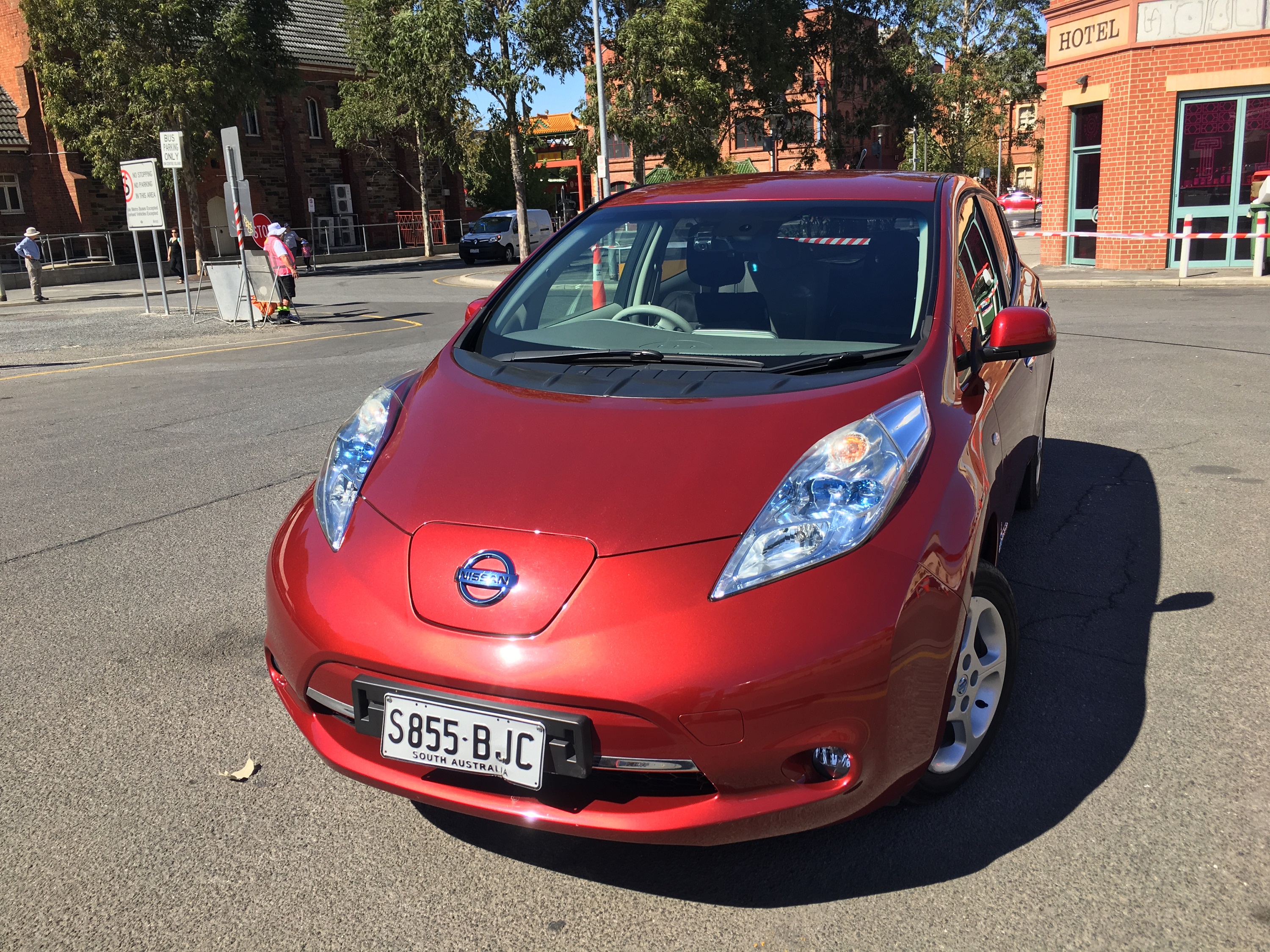
An older model Nissan Leaf. The latest version doesn’t have “eyes” that bug out quite so much.
I didn’t actually ride in a Nissan Leaf but I did have a long talk with an owner and had a good look at one. It’s a small family car/C-segment/compact/medium sized car. The latest model has a 40 kilowatt-hour battery and a range of about 240 kilometers. It starts at about $43,000 Australian in the US after adjusting for GST, but in Australia it costs DIVIDE BY ZERO ERROR because you probably won’t be able to get your hands on one. It may be available in a year for $50,000 or it may not.
Nissan Doesn’t Want To Sell Electric Cars In Australia
Talking to people at the Charge Together event, I definitely got the impression that Nissan doesn’t want to sell the Leaf in this country. Not now at least. One person said he couldn’t get a test drive while another said he was quoted $35,000 as the cost of a replacement battery pack. After adding on our GST a replacement battery pack in the US is $7,860 ($5,500 US plus 10%). In other words, Nissan effectively won’t sell you a replacement battery pack — but they have no problem replacing those that fail while under warranty.
I can understand if Nissan wants to see how their latest model Leaf performs in the US before selling it in Australia’s hotter climate, but I don’t understand why they would want to piss off older Leaf owners by refusing to replace old battery packs. They are the best salespeople the company could have as they all seem to love their Leafs.
Tune In For The Exciting Sequel
Those are the five cars I checked out at the event. Before long I’ll write an exciting sequel where I’ll describe what I learned about range anxiety or “range excitement” as it was optimistically described by one person, the various methods of charging your electric car including how to find someone in the middle of nowhere with a socket you might be able to get a charge from, and some interesting electric car trivia.
I’ll also explain why electric car owners have such tiny rooftop solar systems.
Footnotes
- Isaac Newton said that if he had seen a little further it was only because he had stood on the shoulders of giants. It felt like he was using his position upon the shoulder of a giant to command it to step on me. ↩
- The range extender is designed to allow Europeans to drive what they think is a long way and so is far from ideal for Australians heading beyond the black stump, but will make long distance driving much easier. ↩
- A typical hybrid charges its small battery using its petrol engine and also by braking. A plug in hybrid does the same but also lets you plug it into a socket and charge the battery. Some plug in hybrids have a large enough battery and enough electric motor power to allow you to do almost all your around town driving with electricity only. With an 8.9 kilowatt-hour battery the plug-in IONIQ should be able to travel around 60 kilometers just on battery power, although the petrol engine will probably kick in when you go up hill. ↩

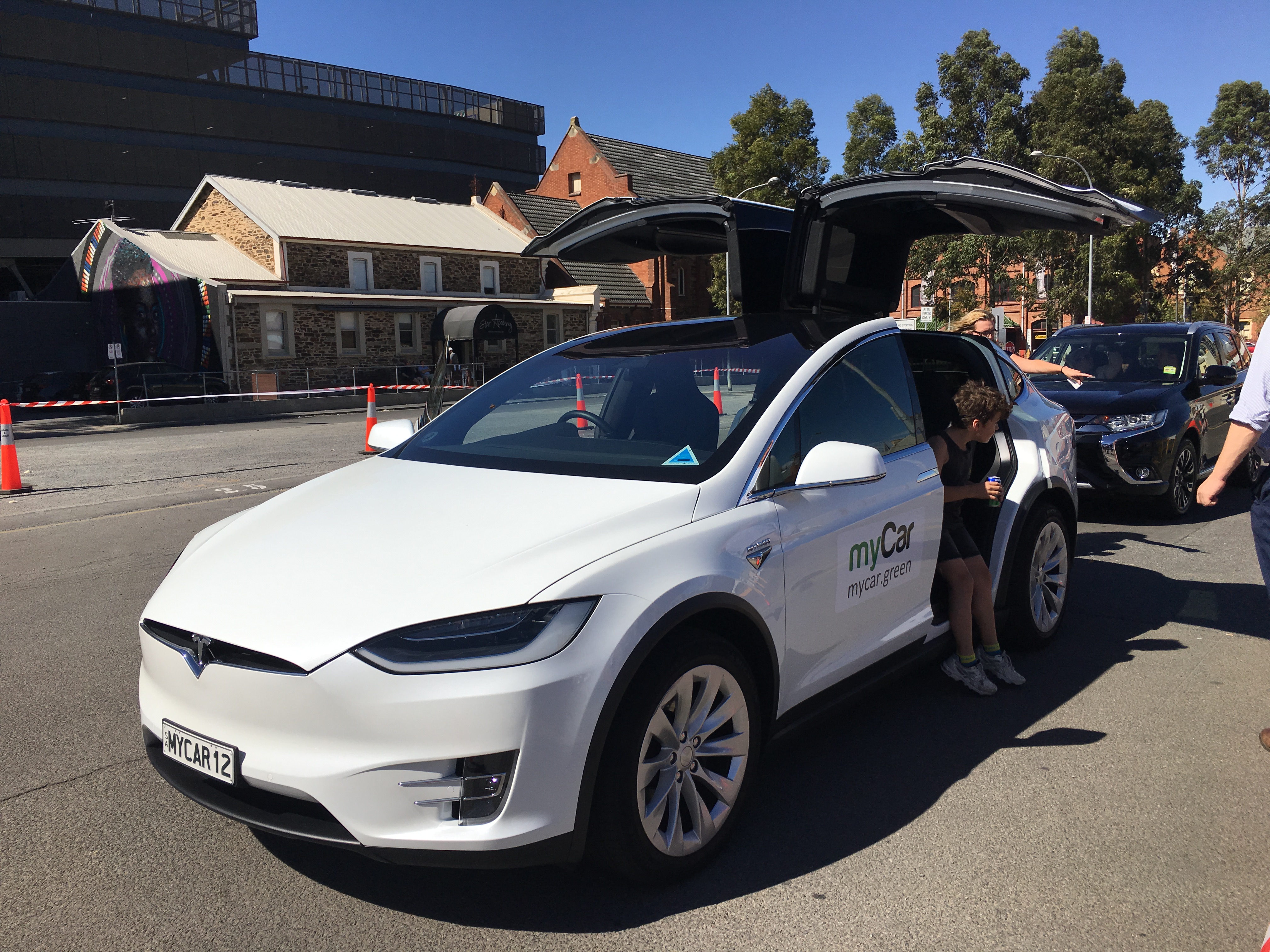
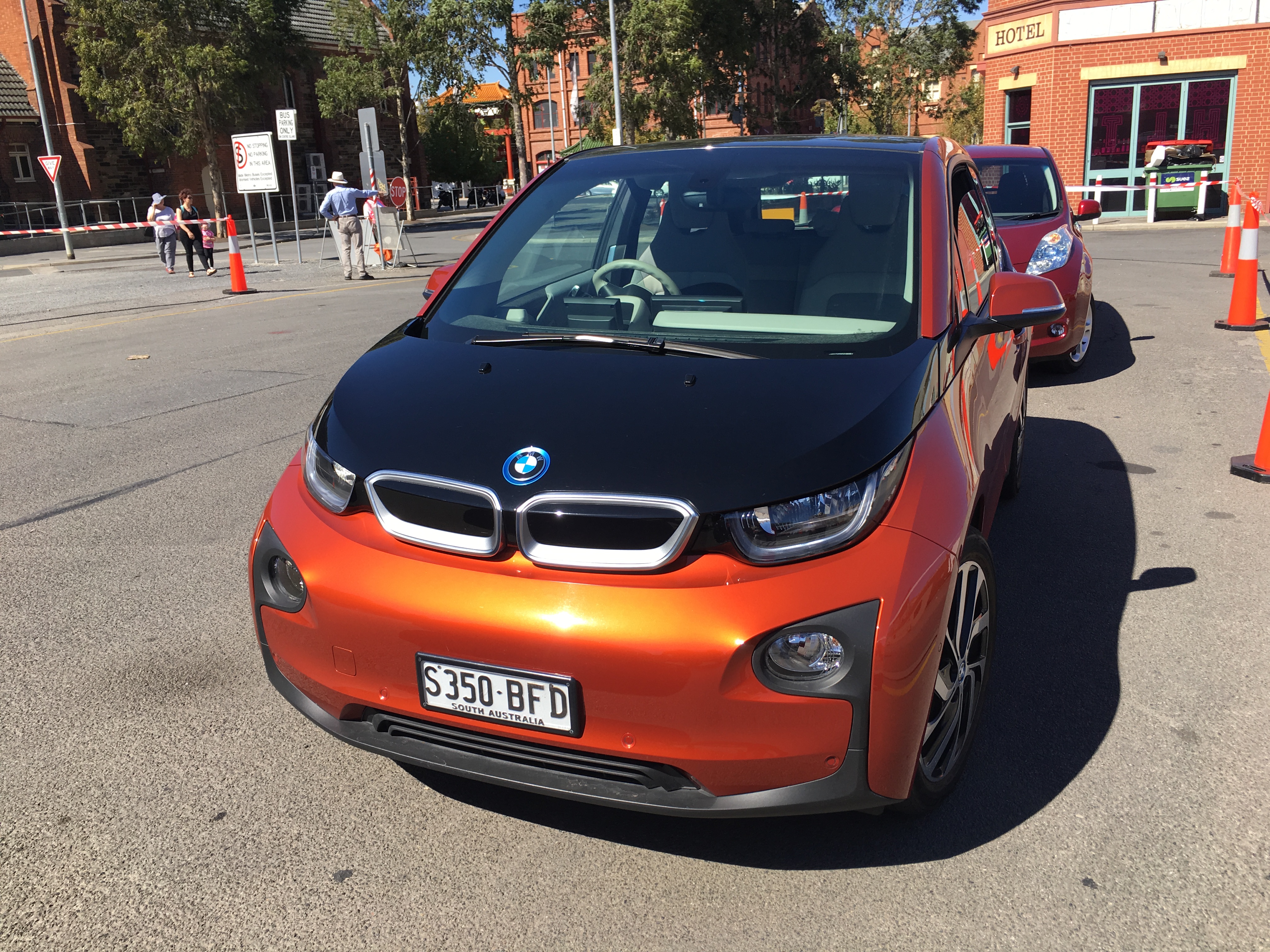
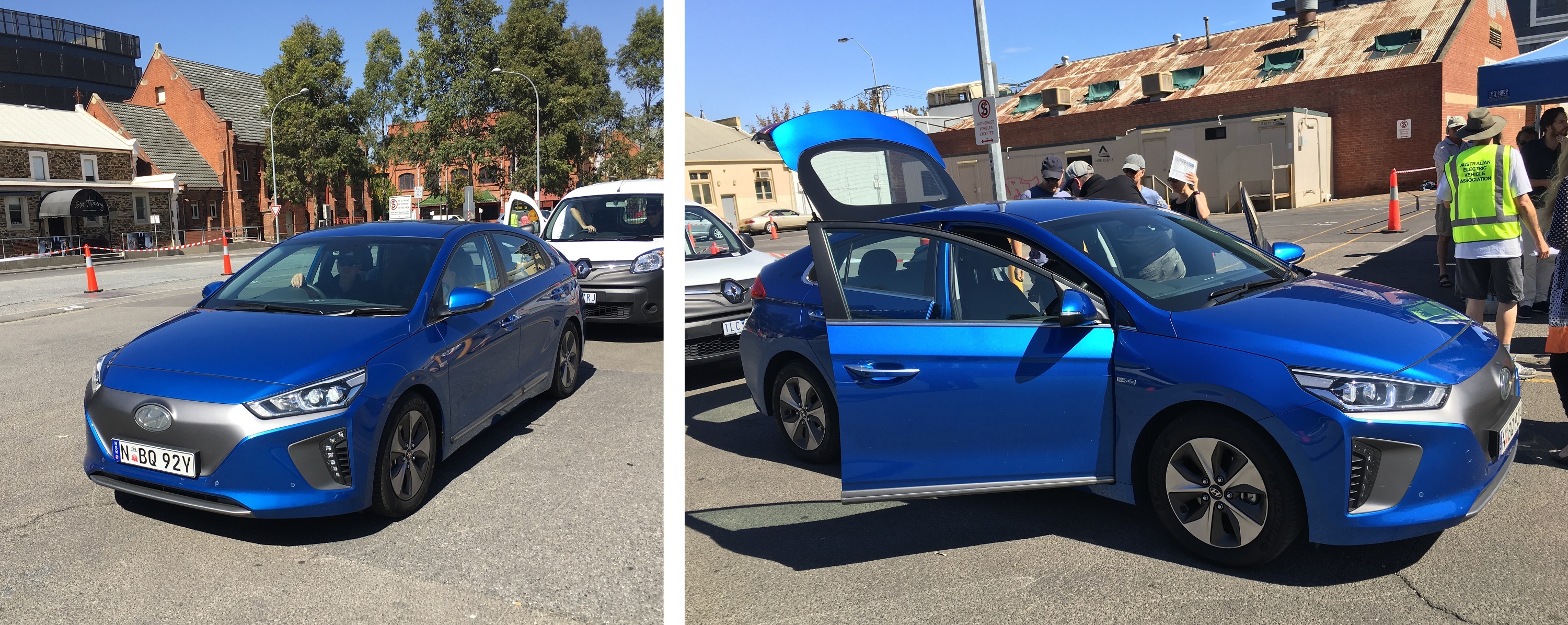
 RSS - Posts
RSS - Posts



Your enthusiasm is certainly contagious,Ron. Will you publish the performance figures when you fit batteries and electric motors to Tonto 23~ or will you keep him as -is in case your EV needs a tow home, and your girlfriend won’t get out and push?
……..or perhaps you could connect the vehicle’s battery to Tonto with a jumper-lead ~ though you’d have to carry a pointy stick to get the dear old nag to…er, jump.
???? Since, as I understand it, there are more horses in Australia today than there were in 1855, would there be a market for commercial Knacker-Klackers?
I can give you the current efficiency figures for Tonto 23. Unfortunately muscle is only about 25% efficient at converting chemical energy in food into movement. This similar to efficiency of burning horse feed to generate electricity to power an electric vehicle, but Tonto 23 has a huge loss of energy due to his basal metabolic rate. In other words I can switch an electric car off, but I can’t switch my horse off. Or at least only once.
hmm. Interesting train of (energy-consuming) thought. But you seem to overlook the other ‘efficiencies’ provided by Tonto’s metabolic rate. eg producing fertiliser and methane from otherwise-non-efficient solar energy consumers ~ eg carrots.
Incidentally, do you have similar efficiency-ratings for the girlfriend….or do we just assume carrot-conversion (assuming similar quality carrots) is common across the broad?
Muscle is probably of similar efficiency whether it is in an insect or human. But cows and kanagaroos are more efficient at digesting cellulose than horses are. Humans don’t digest cellulose at all (well, maybe a tiny amount) but we don’t eat much of it compared to cows and horses, so I digestion is still reasonably efficient.
Apologies if this issue has been addressed elsewhere on this site but does anyone know, ballpark percentage figures accepted, what size solar system would one need to feed both a house and an EV? I realise that’s a ‘how long is a piece of string’ question hence the percentage qualifier.
I reckon a 10 KW system will produce about 40 kWh of energy. Split this 50% house 50% car. This 20 kWh may get you around 150 km.
These numbers are consistent with my energy usage and efficiency of my i3 assuming some freeway driving.
The other 20 kWh drives my electricity including hot water but not room heating.
Of course your use case will vary
V2H!
As soon as one manufacturer allows this to happen, I’m in.
Even trying to get any info regarding V2H is like pulling teeth.
Can you do any better, Ronaldo?
Generally Australia’s Distributed Network Service Providers (DNSPs) do not allow vehicles capable to providing power to the grid to be plugged in. Note you’re not just not permitted to use them to supply power to the grid, you’re not allowed to plug them in at all. In Japan they are looking at using electric cars to help provide grid stability, but apparently our grid is stable enough as it is.
But off-grid it’d be difficult for them to obstruct, no?
I have planning approval for my off-grid build – now embarking on building approval, and the PV charger cabinet is adjacent to the garage.
There’s room for 7 kW of panels on the roof, but more could be added on an adjacent roof, if really needed.
Yes, but there wouldn’t be much point in Vehicle-to-Grid capability in that case.
That’s the first mention of V2G I’ve seen, Ron. Off-grid V2H is infinitely more valuable than on-grid V2G, because there’s no grid backup – only an expensive-to-run petrol generator.
OK, an EV-use/Home-use dilemma arises in dark weather, once the fixed battery is flat, but at least there is a choice, beyond arcing up the generator.
It’s something that I’ve pencilled in for my build, even if the EV is only an on-farm ATV.
Sorry, yes, Niels wrote V2H not V2G. My mistake.
Leafs since MY 2014 and Outlander PHEV since MY 2015 (if not earlier!) support V2H/V2G without modifications through the ChaDeMo DC port.
Shhhhh!
I won’t tell any DNSPs if you don’t.
I am aware that the Japanese Leaf’s (Leaves?) support V2H. Interesting news about the Outlander though. This may be an indication that other manufacturers will start supporting this too – if nothing else, its another selling point.
Not only do all 2014 Leafs support V2H/V2G, the eNV200 does also. Here is a nice video about it from Tesla Bjorn: https://www.youtube.com/watch?v=NDYhihUbovM
Rno, I really appreciate the effort you go to in writing these articles.
Re electric cars I think you should reframe how you talk about them.
The correct framing in my view is that an emissions concious person can dramatically reduce emissions with a plug in electric car and buying green power for recharging it.
.To do analysis on the baiss of the grid’s average emissions is I think not the correct way to do the analysis because I believe that in the main probably about half the charging of plug in electric vehicles is done with green power including charging at home overnight.
The main motivation for buying a plug in electric vehicle is to reduce emissions. Those who buy a plug in Electric Vehicle pay a big capital costs so, given that they are willing to do so to reduce emissions, why wouldn’t they be buying green power for their residence,
So the proper question in my mind is how much can an emissions concsious person reduce theri emissions with a plug in EV and green power compared to an equivalent size car with Internal combustion engine? And you can do the comparison with or without considering the emissions in the building and scrapping of the car with less error if you are comparing like sized cars.
Those who are framing the analysis using an average grid are framing the debate ignoring the likely choice of green power by people who are emissions conscious so they get an answer that is less in favour of electric vehicles. Don’t fall for it! Frame it as how much can be achieved with the combination of PEV or PHEV and green power for recharging.
Back to the importance of framing the issue correctly.
You say ” But not one of them had a solar power system large enough to offset the electricity consumption of a typical household plus an electric car.” but that is the wrong framing. Who cares whether they can charge their car from their own solar? The question is whether the power they use for recharging is from true renewable, low emissions power like wind or hydro or, during the day, solar. All those who didn’t have a big enough solar array may well buy only low emissions power from their retailer for the places where the car is charged. Many cars would be being charged at night so it wouldn’t matter how big the domestic solar array was, it wouldn’t be charging the car except from another battery.
Its not who produces the power used for charging, it is whether the power used for charging is low emissions.
Back to the importance of framing the issue correctly.
Good idea!
You say ” But not one of them had a solar power system large enough to offset the electricity consumption of a typical household plus an electric car.”
What’s that? ( “a typical household”), and can you pin-point one of them that has a single car?
Separating out the cost of the battery into an annual leasing fee can be a great way to look at the cost of an EV.
When you buy an ICE you are impliedly entering into a contract to buy fuels from the cartel of oil producers and their distributors and for most people that contract is for about $2000 pa (15,000km pa, 10L/100km, 1.30/L).
They are also impliedly contracting to buy all those services that are say $200 more each than for an EV
So when you buy an EV but lease the battery it makes the capital cost of the EV much more comparable to the capital cost of an ICE car because the charging electricity is about the costs of the services. (you can probably do a more sophisticated analysis of this than I, but that’s my back of the envelope calculation.)
Separating out the battery cost is actually a good way of doing the capital cost comparison. Alternatively wyou should add to the capital cost of the ICE car all the addiitional costs of services, fuel and repairs and discount them to the Net Present Value. But the ICE car maufacturers and dealers won’t like that because it makes a car appear hideously expensive, which it is!
Noted earlier your comment that subsidies for EVs made sense if we powered them by solar.
So what do you believe _is_ the very best way to accomplish this, Ron?
Meanwhile (drool…): https://electrek.co/2018/04/12/tesla-model-3-canada-incentives/
Well, getting some quotes from us is a pretty good way to start.
But even if every electric car manufacturer agreed to install enough solar to power every car they sell, it would still make sense to make polluters pay for what they do. (And this can be done without making current car owners pay more on average than they already do.)
“Well, getting some quotes from us is a pretty good way to start… .”
Funnily enough, I was hoping for something a little more specific than that, Ron 🙂
A carbon price equal to the cost of removing and sequestering CO2 released from burning fossil fuels would result in rapid closure of Australia coal power stations and rapid expansion of solar power. This might be $70 a tonne. It wouldn’t have to start at that level, but could build up to it over time.
….Aye ~ there’s the rub, as Bill said.
ALL the figures discussed here are variable on umpteen levels, and today’s gospel is tomorrow’s heresy.
The whole subject is founded upon the assumption that vehicle ownership (and energy-use generally) is an absolute god-given right ~ and that species-survival (via equally-absolute current ‘economic considerations’) depends upon it. There’s a strong argument to be made that current concepts re. both energy consumption and economic mantras are both wrong in principle and unsustainable in fact.
The single most ~ inevitable ~ destructive …er, ‘vehicle’ in terms of species survival is that other
religious furphy:- that breeding like rabbits on Viagra is also a god-given ‘right’.
We’re witnessing the growth of homosaps/consumption rates of cancerous proportions/consequences and sit around haggling over how to best trim our toenails.
Doubling the number of vehicles ~ even if it were somehow possible to double the efficiency of energy-consumption is never going to be a solution to species-suicide.
We saw an example of that in the early ’60s, when simultaneously vehicle-efficiency increased exponentially (thanks mainly to the Japs), and traffic increased exponentially+ 15% because for the first time females took to the roads in droves. (Instead of pushing a pram to the shops for the week’s shopping my mother drove miles almost every day to check out the same products elsewhere.)
And the solution to this overwhelming change in the evolutionary stencil?
Build more freeways!… sorry, gridlocks.
Don’t worry, us women check our specials now online in the kitchen (where we belong) before driving to the shops. 🙂
Thanks Ronald. What is disappointing for me, is that apart from the Tesla X, the total focus of electric cars builders is in the small to tiny car market. As a big guy with family of elderly parents to transport these vehicles are unacceptable. I have installed a large (13.2kW) solar system on my roof with the intention of purchasing an electric family size vehicle. With the cost of the X being prohibitive I guess it won’t be anytime soon. Did you get any feeling that the manufacturers may be intending to broaden their rangers?
Well, there’s the Mitsubishi Outlander plug-in hybrid which can apparently be driven over 30 kilometers in town on electric power alone. I haven’t been inside one of them though.
In about 2-3 years Tesla will have the model Y, which will be a mass market SUV (would still be $60-70k). Supposedly production will start next year, but Tesla’s timelines….
We are in the very early stages of thinking about Hybrid and/or electric car. Motivation is NOT green but saving money. We are concerned about FiT going down and petrol going up. However, we have no idea if a change from my current 2019 Honda Jazz to a hybrid is worth it. We are pensioners so can’t waste money. We have 10Kw solar on the roof. Would love some sensible advice.
Hi Geertje
If you are going to get a new car anyway, then it should make sense to get a hybrid. But if you are happy to keep your current car then then you’ll be paying a considerable amount for a new hybrid. If you drive 13,000 km a year, petrol averages $2 a litre, and you get a hybrid that gets 30 km a litre; then you might save around $750 a year. While that’s a substantial amount of money, it’s not a lot compared to the premium you’d have to pay for a new, highly efficient, hybrid car.
If you were looking for a high end car I’d recommend looking at electric vehicles but, as that’s not the case, you may want to keep your Jazz for a few years and then see what hybrid and electric vehicles are available. I expect EVs will have come down in price. With an electric car you should be able to almost always charge it from your rooftop solar if it’s often parked at home during the day.
I’ve got a similar ‘problem’ to Geertje, and I’m in the same age group.
I’ve got a very reliable 2002 ICV unleaded fuel vehicle,that’s got a very low market value. About 90% of its usage is for short trips to the shops once every 2 weeks, and when I need to make a longer trip I usually time it so I can do shopping as well.
I also pay close attention to basic maintenance such as keeping radiator topped up, keeping engine tuned, battery fully charged along with brake fluid, engine oil, tyre pressures, replacing tyres etc. It’s done well under 100K, and the likelihood of me living long enough to ever reaching 150k total is virtually zero, while the 100K mark is looking a bit doubtful too.
So, having minimized the pollution impacts of vehicle as much as I can, at present EV prices there’s just no way that you can talk me into coughing up even say $20- 25K, (let alone$60-$70K) . I can do other things with that cash to reduce my environmental impacts, food, water, and energy costs to a far greater extent.
Everyone’s personal work and family circumstances are different of course, and for most families with children still at home, a second vehicle is virtually a necessity, and an EV might well be worth the outlay to them. Similarly for families where long commutes to work are required.
The main point I’m making is that its well worth giving a lot of preliminary thought before racing out to buy an EV., just as you should for roof-top solar. There may well be changes you can make to your personal transport needs and work circumstances that will ensure you end up the EV that’s the most suitable for you.
Geertje,
“We are concerned about FiT going down and petrol going up. However, we have no idea if a change from my current 2019 Honda Jazz to a hybrid is worth it.”
Accumulating indicators I see suggest it would be foolish to assume petroleum fuel supplies in Australia will remain plentiful and affordable for the longer-term – see my comments at: https://www.solarquotes.com.au/blog/real-world-ev-range/#comment-1362303
FWIW, I’d suggest you keep your 2019 Honda Jazz in good working condition for as long as possible, if and until there are more compelling EV options available for you.
I certainly won’t be buying any new vehicle with an internal combustion engine.